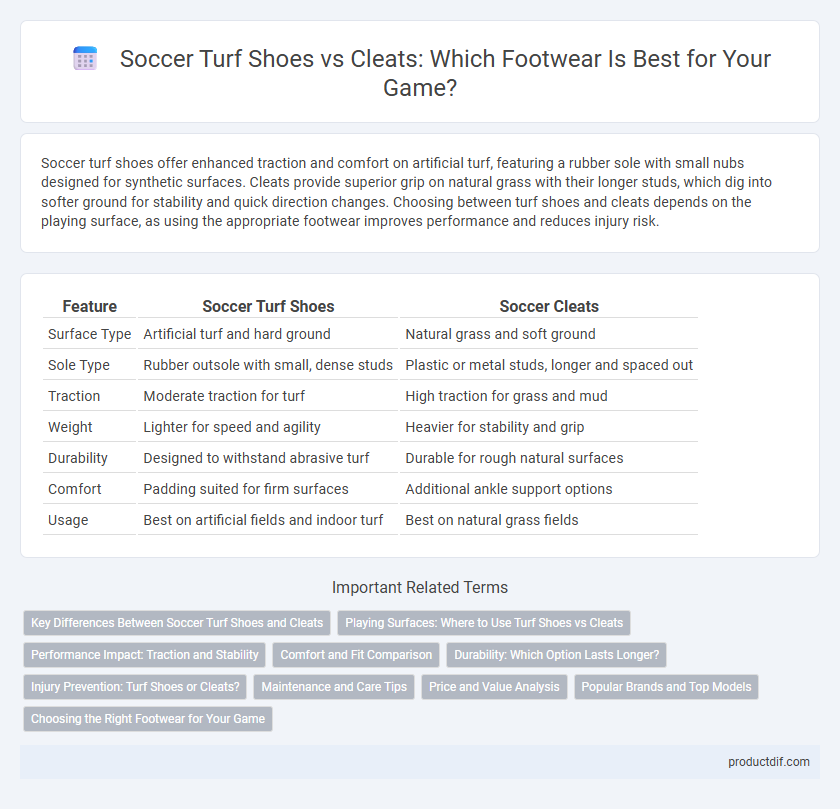Soccer turf shoes offer enhanced traction and comfort on artificial turf, featuring a rubber sole with small nubs designed for synthetic surfaces. Cleats provide superior grip on natural grass with their longer studs, which dig into softer ground for stability and quick direction changes. Choosing between turf shoes and cleats depends on the playing surface, as using the appropriate footwear improves performance and reduces injury risk.
Table of Comparison
| Feature | Soccer Turf Shoes | Soccer Cleats |
|---|---|---|
| Surface Type | Artificial turf and hard ground | Natural grass and soft ground |
| Sole Type | Rubber outsole with small, dense studs | Plastic or metal studs, longer and spaced out |
| Traction | Moderate traction for turf | High traction for grass and mud |
| Weight | Lighter for speed and agility | Heavier for stability and grip |
| Durability | Designed to withstand abrasive turf | Durable for rough natural surfaces |
| Comfort | Padding suited for firm surfaces | Additional ankle support options |
| Usage | Best on artificial fields and indoor turf | Best on natural grass fields |
Key Differences Between Soccer Turf Shoes and Cleats
Soccer turf shoes feature a flat, rubber sole with small nubs designed for artificial turf, offering enhanced traction and comfort on synthetic surfaces. Cleats have longer, molded studs intended for natural grass, providing superior grip and stability on uneven terrain. Turf shoes prioritize flexibility and multi-directional movement, while cleats focus on maximum penetration and performance in outdoor grass conditions.
Playing Surfaces: Where to Use Turf Shoes vs Cleats
Turf shoes are designed with small rubber studs for optimal traction on artificial turf, providing better grip and reduced injury risk on harder, synthetic surfaces. Cleats feature longer, often molded or detachable spikes ideal for natural grass fields, offering deeper penetration for enhanced stability and maneuverability. Choosing between turf shoes and cleats depends primarily on the playing surface, ensuring maximum performance and safety during soccer play.
Performance Impact: Traction and Stability
Soccer turf shoes feature small, rubber studs designed to maximize traction and stability on artificial turf, reducing the risk of slipping and allowing for quick directional changes. In contrast, soccer cleats have longer, molded or detachable studs tailored for natural grass, providing deeper ground penetration and superior grip during aggressive sprints and sudden stops. Choosing the correct footwear based on playing surface significantly enhances performance by optimizing traction and stability in various soccer environments.
Comfort and Fit Comparison
Soccer turf shoes provide enhanced comfort with cushioned midsoles and flexible outsoles designed for artificial turf, reducing foot fatigue during play. Cleats, featuring molded or detachable studs, offer superior traction on natural grass but may compromise comfort due to rigid soles and pressure points. Selecting between turf shoes and cleats depends on prioritizing cushioning and fit for synthetic surfaces versus grip and stability on grass fields.
Durability: Which Option Lasts Longer?
Soccer turf shoes typically feature synthetic rubber soles designed for abrasive artificial surfaces, offering moderate durability but wearing out faster under intense use. Cleats, constructed with tougher molded or metal spikes on more robust soles, provide enhanced longevity on natural grass fields due to their resistant materials and structure. Durability depends on playing surface and frequency of use; cleats generally outlast turf shoes on grass, while turf shoes are optimal for artificial fields despite shorter lifespan.
Injury Prevention: Turf Shoes or Cleats?
Soccer turf shoes provide enhanced traction and cushioning on artificial surfaces, reducing the risk of common injuries such as abrasions and ankle sprains. Cleats offer deeper studs designed for natural grass, improving grip but increasing the likelihood of turf toe and lower leg injuries on harder turf fields. Choosing the right footwear depends on the playing surface and injury prevention priorities, with turf shoes often favored for minimizing impact-related injuries on synthetic fields.
Maintenance and Care Tips
Soccer turf shoes require regular brushing to remove dirt and debris, along with air-drying after use to maintain their shape and prevent odor buildup. Turf shoes benefit from cleaning with mild soap and water while avoiding harsh chemicals that may degrade the rubber soles. Cleats need thorough cleaning of mud and grass from the studs, regular inspection for worn or damaged spikes, and dry storage to prevent rust and deterioration of metal components.
Price and Value Analysis
Soccer turf shoes typically cost between $40 and $100, offering durable rubber soles designed for artificial grass, while cleats range from $50 to over $200, featuring molded or detachable studs for natural grass traction. Turf shoes provide greater value for players on synthetic fields due to enhanced comfort and less wear on the sole, whereas cleats are essential for optimal performance on natural turf, justifying their higher price with improved grip and stability. Budget-conscious players should weigh durability and playing surface compatibility when choosing between turf shoes and cleats to maximize performance and investment.
Popular Brands and Top Models
Nike and Adidas dominate the soccer turf shoes and cleats market with popular models like the Nike Phantom GT and Adidas Copa Sense. Turf shoes such as the Nike Tiempo Legend 9 Turf offer superior traction on artificial surfaces, while cleats like the Adidas Predator Edge provide enhanced grip on natural grass. Puma's Future Z also ranks high for versatility between turf and cleats, making it a top choice among athletes.
Choosing the Right Footwear for Your Game
Soccer turf shoes provide enhanced traction and comfort on artificial surfaces, reducing the risk of slipping and joint strain during fast-paced play. Cleats, designed with longer studs, offer superior grip on natural grass fields, improving stability and agility in diverse outdoor conditions. Selecting the right footwear depends on the playing surface, with turf shoes ideal for synthetic fields and cleats best suited for natural grass to optimize performance and prevent injuries.
Soccer Turf Shoes vs Cleats Infographic

 productdif.com
productdif.com